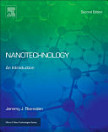Applied Nanotechnology
окт. 2009 г. · William Andrew
Е-книга
200
Страници
family_home
Соодветна
info
reportОцените и рецензиите не се потврдени Дознајте повеќе
За е-книгава
Applied Nanotechnology: The Conversion of Research Results to Products examines the commercial and social aspects of nanotechnology. The book is organized into four parts. Part 1 presents an overview of nanotechnology. It discusses the definition of nanotechnology; the relationship between wealth, technology, and science; the relationship between nanotechnology and innovation; and the question of why one might wish to introduce nanotechnology. Part 2 explains the nanotechnology business and the applications of nanotechnology in a wide range of industries, including engineering, aerospace, automotive, food, textiles, information technologies, and health. Part 3 deals with specific commercial and financial aspects. These include business models for nanotechnology enterprises, demand assessment for nanotechnology products, and the design of nanotechnology products. Part 4 looks at the future of nanotechnology. It examines how nanotechnology can contribute to the big challenges faced by humanity, such as climate change and terrorism. Ethical issues are also considered, including risk, uncertainty, and regulation.
За авторот
Jeremy Ramsden was educated at the Universities of Cambridge and Princeton and the Ecole Polytechnique Federale de Lausanne (EPFL), where he obtained his doctorate in the Institute of Chemical Physics for research into photocatalytic semiconductor nanoparticles. He was a visiting scientist at the Biocenter (Institute of Biophysics) of the Hungarian Academy of Sciences in Szeged (1987), after which he worked at the Biocenter (Institute of Biophysical Chemistry) of the University of Basle (member of the Faculty of Natural Philosophy) until being appointed (2002) Professor and Chair of Nanotechnology at Cranfield University in the UK. From 2003–9 he was also Research Director for Nanotechnology at Cranfield University at Kitakyushu in Japan. In 2012 he moved to the University of Buckingham (UK) as Honorary Professor of Nanotechnology. His main research focus nowadays is on nanosensors. He is a Fellow of the Institute of Materials, Minerals and Mining (London) and a IUPAC Fellow.
Оценете ја е-книгава
Кажете ни што мислите.
Информации за читање
Паметни телефони и таблети
Инсталирајте ја апликацијата Google Play Books за Android и iPad/iPhone. Автоматски се синхронизира со сметката и ви овозможува да читате онлајн или офлајн каде и да сте.
Лаптопи и компјутери
Може да слушате аудиокниги купени од Google Play со користење на веб-прелистувачот на компјутерот.
Е-читачи и други уреди
За да читате на уреди со е-мастило, како што се е-читачите Kobo, ќе треба да преземете датотека и да ја префрлите на уредот. Следете ги деталните упатства во Центарот за помош за префрлање на датотеките на поддржани е-читачи.






